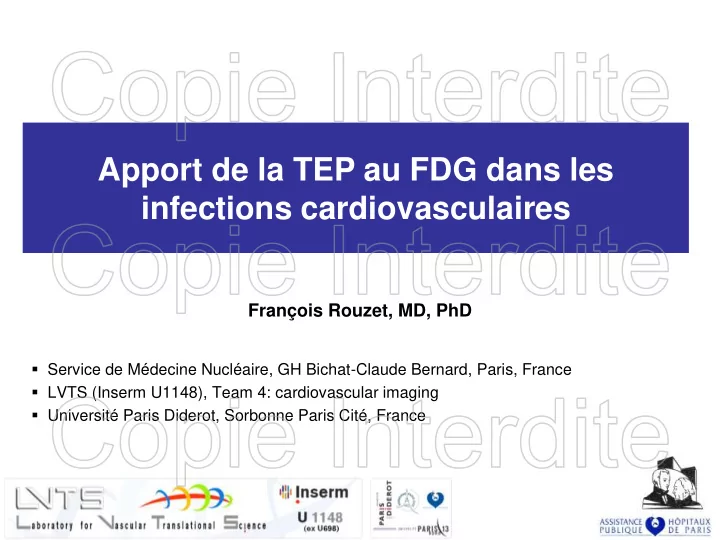

Apport de la TEP au FDG dans les infections cardiovasculaires François Rouzet, MD, PhD Service de Médecine Nucléaire, GH Bichat-Claude Bernard, Paris, France LVTS (Inserm U1148), Team 4: cardiovascular imaging Université Paris Diderot, Sorbonne Paris Cité, France
18 FDG PET/CT for detection of metastatic infection in Gram-positive bacteraemia Vos FJ et al., J Nucl Med. 2010
50% metastatic foci were asymptomatic Vos FJ et al., J Nucl Med. 2010
FDG PET in bacteraemia: impact on outcomes Mortality (6-month) : 19% vs. 32% Relapse (3-month) : 2.6% vs. 7.4% S. aureus subgroup : 1.4% vs. 8.9% Vos FJ et al., J Nucl Med. 2010
Infective endocarditis: embolic events Patients: • Single centre prospective study • 71 patients (mean age: 55 y-o) suspected of IE • HFLC beverage 45 min before FDG injection • Valve: prosthetic (n=38); native (n=33) Results: • Unexpected extracardiac findings: 17 patients (24%) • Antibiotic therapy at the time of PET/CT: 14/17 Bonfiglioli et al., Eur J Nucl Med. 2013
“True” whole -body acquisition oncology-derived field of acquisition: skull base to upper thighs
Imaging of the brain: FDG not optimal Trans Arterial Valve Implantation
Detection of mycotic aneurysms of lower limbs by whole-body 18 FDG PET Potentially severe complication of IE Incidence probably underestimated PET/CT CT angio Mikaïl N et al., JACC CV Imaging (in press)
Mycotic aneurysms A B C D E F
Mycotic aneurysms Recurrent finding of mycotic aneurysms of branches of femoral arteries, in relation with the extension of the field of acquisition of FDG PET/CT. Seems to be associated with haemorragic stroke Potential impact on IE management
Portal of entry Recurrent chills, fever, and positive blood cultures ( E. faecalis ) Suspicion of aortic prosthetic valve infection
Valve (primary) lesion Patients: • Single centre prospective study (2005-2008) • No HFLC diet • 72 patients suspected of infective endocarditis • 18 (25%) with definite IE (Duke criteria) Results: • Sensitivity: 39%; specificity: 93%; PPV: 64%; NPV: 82% Outcomes Kouijzer et al., Eur J Nucl Med. 2013
Analysis of myocardial FDG uptake – High Fat Low Carbohydrates (HFLC) diet Insulin-dependent diabetes ? • 12-hour fasting • Blood glucose: 12.6 mM • No myocardial uptake of FDG
Analysis of myocardial FDG uptake – Prosthetic valves: non attenuation-corrected images Attenuation No attenuation correction correction
Prosthetic valve endocarditis (PVE) − Delay >1 month after valve implantation (IQR: 526 to 3,396 days) − Median delay: 9 days (IQR: 5 to 19 days) after the beginning of antibiotherapy (n=55) − Positive PET/CT (n=36) in patients with biological and mechanical prosthetic valve: 52% vs. 46% (p=0.63) Saby et al., JACC 2013
Prosthetic valve endocarditis TBR SUVmax Saby et al., JACC 2013
Erba PA et al, J Nucl Med 2012 True-positive: 46 /51 ; False-negative: 5 /51 cases (90% sensitivity, 94% NPV, and 100% specificity and PPV)
FDG PET vs. WBC SPECT ? • Single-centre prospective study (Bichat Hospital, Paris) • 39 patients (males: 22), aged 62 17 years • Suspected of prosthetic valve endocarditis (PVE) • Delay between FDG PET and WBC SPECT: 7 7 days • Diagnosis after 3-months follow-up (Duke-Li): – Definite, n=14 (36%) – Possible, n=3 – Rejected, n=21 Rouzet F et al, J Nucl Med 2014
FDG PET vs. WBC SPECT ? Final diagnosis after 3 mo follow-up Definite Possible Rejected (n=14) (n=4) (n=21) FDG PET + 13 (93) 1 6 FDG PET - 1 2 15 (71) WBC SPECT + 9 (64) 0 0 WBC SPECT - 5 3 22 (100) FDG PET false positive <2 months after valve implantation (n=6) WBC SPECT false negative (n=5): Coxiella (n=2), Candida (n=1), no abscess (n=2)
Detection of perivalvular regurgitation 40 days after valve replacement for PVE ( Nesseria sicca ) No event during 6- months follow-up True negative WBC SPECT
18 FDG uptake pattern in non-infected prosthetic heart valves Mathieu C et al, SNM 2015
CIEDs infection 40 controls 10 patients FUO (despite TEE) 18 FDG PET 4 negatives 6 positives 37 normal (93%) 1 year follow-up Removal of the devices No event Microbiological cultures: + Ploux et al, Heart Rhythm 2011
CIEDs infection Ploux et al, Heart Rhythm 2011
Sarrazin et al, J Am Coll Cardiol 2012
PET - AC PET - NAC Group A Group B Group C
Delayed (3-hour) imaging NAC AC PET/CT 1 hour (3-4 min/bed) 3 hours (6-8 min/bed) Leccisotti et al, J Nucl Cardiol 2014
Delayed (3-hour) imaging (n=6) (n=11) Leccisotti et al, J Nucl Cardiol 2014
Summary WBC scintigraphy − Well established in infection − Specificity +++ FDG PET in infective endocarditis – Allows early identification of • Septic emboli / metastatic infection • Portal of entry – Impacts on diagnosis of PVE – Impacts on patients’ management Flowcharts – Saby L. et al., JACC 2013 – Iung B. et al., Q J Nucl Med Mol Imaging 2014 – ESC/EANM guidelines on infective endocarditis (Hamburg 2015)
Perspectives: FDG PET Remains to be determined Cost-effectiveness Diagnostic value, impact on patients’ management and outcomes in multicentre trials • NCT01916005 - F. Thuny, Marseille, France Diagnostic Value of 18F-fluorodeoxyglucose Positron Emission Tomography/Computed Tomography in Prosthetic Valve Endocarditis. • TEPvENDO - X. Duval, Bichat, Paris, France Diagnostic and therapeutic impact of FDG PET at the acute phase of infective endocarditis (8 centres). • ENDOTEP - P. Bordachar, Bordeaux, France. Assessment of the diagnostic accuracy of FDG PET in the diagnosis of cardiac devices infection: a prospective multicentre study.
Perspectives: new imaging agents Leukocytes labelled with positron emitters (PET) • Requires a long half-life isotope ( 64 Copper = 12.7 hours) • Bhargava et al. NMB 2009 99m Tc-Annexin A5 • Target: vegetations (phosphatidylserine expressed by activated platelets) • No physiological uptake in heart and brain AnnIE Sponsor: Inserm Proof-of-concept study Patients suspected of IE Kick off: 2015 Rouzet et al., Circulation 2008 Benali et al., Mol Imaging 2014
Recommend
More recommend